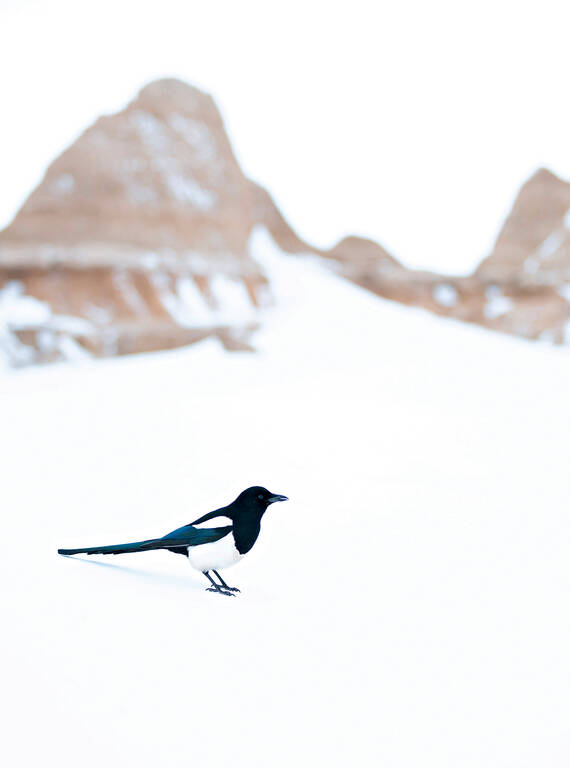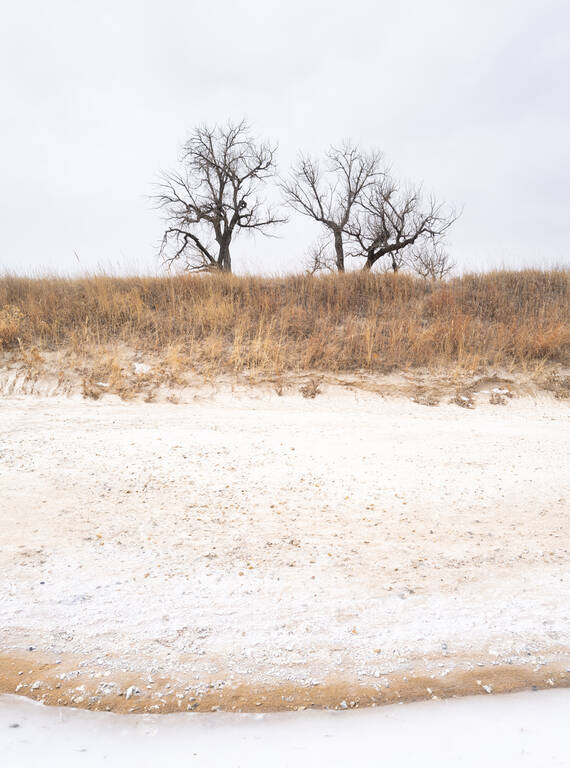Fall 2023
'Peace, Life & Tingly Happiness'
Photographer Matt Brass and filmmaker Jesse Brass carefully planned a visit to South Dakota to shoot Badlands National Park. A winter storm changed everything.
For nearly a decade, when my kids were small, our family made an annual summer road trip from our home in Tennessee to Colorado. We loved the cool weather and majestic views of the mountains. One year, almost as an afterthought, we decided to return home via South Dakota. After driving 10 hours out of our way, we arrived in Rapid City tired and a little cranky, only to discover that the motorcycle rally in nearby Sturgis was in full swing and hotels were booked. Someone suggested we try to get a campsite in Badlands National Park. Out of other options, we heeded the advice and headed east.

An Insider’s Guide to Badlands & Beyond
Badlands National Park is a vast wilderness of jagged buttes, spires and pinnacles, mixed-grass prairies, and the world’s richest trove of fossils from the Oligocene epoch, estimated at 23…
See more ›As we pulled into the campground, we were greeted by a purply-pink sunset illuminating an otherworldly landscape. I was stunned. I’d never seen anything like it. Over the next several years, the Badlands became my favorite part of our summer routine. Mornings and evenings in the park never ceased to take my breath away.
Over time, I began to read about the history of the area. Biographies of Lakota figures such as Red Cloud, Sitting Bull and Crazy Horse offered insight into the lives of Native Americans in the region and conflicts between Tribes and white settlers. The intensity of winter was central to many of these narratives. That caught my attention. In the Badlands, summer was far from accommodating. Searing heat, gale-force winds and sudden storms could instantly put you in your place. I wondered: What must winter be like?
Well, this past year, I decided to find out. My brother, Jesse Brass, a filmmaker whose family had accompanied us on one of our summer journeys, decided to join me. (See his film at the end.) In December, we loaded up our smallest and most fuel-efficient car and embarked on the 20-hour drive, arriving after dark on a Sunday. The evening was mild and pleasant, and the skies were clear, so we spent a few hours photographing stars at the east end of the park’s North Unit before calling it a night.
Wind-carved snowdrifts stretch toward rocky pinnacles near the Ben Reifel Visitor Center.
©MATT BRASSA black-billed magpie on fresh-fallen snow at Badlands National Park.
©MATT BRASSIn the aftermath of Winter Storm Diaz, the author’s brother battles blizzard winds to hike to an overlook.
©MATT BRASSA porcupine lumbers through the snow.
©MATT BRASSAn open road in Badlands National Park. After the storm, those double yellow lines would be nearly impossible to see, leading the brothers to hold open the car door at times.
©MATT BRASSA bobcat, a creature deemed “ghostly elusive” by author Richard NeSmith, pauses near a park trailhead.
©MATT BRASSSnowy spires dominate the view from Cedar Pass Lodge, the only restaurant and lodging facility (outside of campgrounds) in the park.
©MATT BRASSDeer forage after the worst of the storm has passed.
©MATT BRASSThe deserted park landscape after Winter Storm Diaz.
©MATT BRASSA rabbit in Badlands National Park.
©MATT BRASSMy three-day itinerary was fairly structured. On Tuesday, I was to meet with a Lakota guide and explore the South Unit, which is co-managed by the Park Service and Oglala Sioux Tribe. Wednesday would be a tour of the fossil sites with a park ranger. Monday was our only open day, so we made the most of it. While photographing the North Unit from top to bottom, we saw only one other human, Phoenix. A Navy veteran, he had, in his own words, pretty much messed up his first life — now he was trying to start a second one. He gave us a few details, but mostly talked about what he called a journey to find “peace, life and tingly happiness.”
We chatted for a good while, marveled at the bison and conversed with a black-billed magpie. Then we went our separate ways. As he got into his car, he shouted over his shoulder, “Remember, the journey is the destination!”
We drove on. We spotted a small group of bighorn sheep and had an extraordinary encounter with a bobcat. We finished the day at the visitor center chatting with the staff about the impending storm and the potential it had to disrupt our Tuesday plans.
About the Filmmaker
Little did we know. For the next hundred hours, Winter Storm Diaz would pummel the High Plains with snow and wind. The subsequent whiteout conditions and closed interstate trapped us in our rental house just a few miles from the park, where we were unable to do much of anything other than eat Pop-Tarts and watch Netflix. On Tuesday, we didn’t even try to get out. On Wednesday and Thursday, we crept toward the park in our two-wheel-drive car — at times holding open the door to see the yellow line and stay on the road — but we were forced to turn around well short of our goal. Friday, blizzard winds continued but were weakening, and we were able to make it to the gate. We left our car outside the park and hiked to an overlook as the wind continued to blast prairie snow off the plateau and into the rugged ravines and canyons below. The warm purples and pinks of the summer had been replaced by December’s icy palette of blues and whites glistening in a sun we had not seen for nearly a week. I was as stunned as I’d been on my first visit to the park. Captivated, we wandered for hours through the deserted landscape.
When the sun started to dip in the sky, we turned into the 35 mph winds and, clutching our icy cameras, headed back to our car. On the way, a porcupine sauntered by. The trip certainly did not turn out as we planned, but for a little while, at least, we’d found it: peace, life and tingly happiness.
Watch Jesse Brass’ Badlands Film:
About the author
-
 Matt Brass Author
Matt Brass AuthorMatt Brass recently retired from his job as vice president of creative at an ad agency specializing in sustainability and the environment after a 17-year run. Since then, he's founded a company, Smoky Outfitters, that creates art about destinations around the U.S., including many national parks. Based in Knoxville, Tennessee, Brass continues to pursue photography and document his adventures in the great outdoors. To learn more, go to mattbrass.com.













